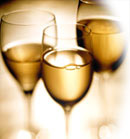White Wine
White wine is best defined by what it lacks. In other words, white wine is wine without the red pigment that makes red wine red. White wine is rarely purely white or clear. The color of white wine can range from light yellow to gold and is sometimes even pale green.
White wine is often (but not always) made from the juice of white grapes. It can also, occasionally, be made with the juice of red grapes, but only the juices of the grapes, not the skins. The juice of most red or purple grapes has no red pigment, so a wine made with only the juice of a red grape can be a white wine.
When compared to red wine, white wine is often described as less full-bodied (a term used to describe a wine's flavor, richness, and depth). At the same time, whites have their own "personalities". They can range from soft (smooth taste) to crisp (a little tart) to broad (flavor intensive). White wine should be served silghtly chilled at about 45 degrees F so they are considerably cooler than room temperature.
back to top
Chardonnay
Chardonnay is the most recognized type of white wine. It is grown throughout the world, most famously in France. Chardonnay gradpes are also cultivated in several other European regions, including Italy, Spain, and Bugaria, as well as extensively in the United States, Austrailia, South America and to a lesser degree in New Zealand.
The Chardonnay grape has a subtle personality, which allows subsoil minerals and nutrients to infulence its flavor and allows winemakers to build complexity inot it. The most common way to build complexity is by fermenting the wine in oak barrels. The newer the barrel the oakier the wine will taste, the older the barrel the more subtle the oak infuence. Some winemakers choose to ferment it in steel barrels which make the Chardonnay taste flintier and crisper than oak-aged wines.
A good Chardonnay features bold, rich, fruit flavors like apple, fig, melon, pear, peach, pineapple, and citris. It also may posses hints of spice, honey, butter, vanilla, butterscotch, and hazelnut. Most significantly, as a result of oak-barrel aging, Chardonnay is well know for ts oak-accented flavors, which are usually described as vanilla and toast.
back to types of white wines
Sauvignon Blanc
In France, the Sauvignon Blanc grape is grown in Bordeaux and the Loire Valley. It is also grown in Italy, the United States, New Zealand, South America, and South Africa.
When mediocre, Sauvignon Blanc can come across as simply a generic white wine. When it is well made, it is a strong, dry white wine with citrus, often grassy overtones. It serves as a nice, less expensive alternative to Chardonnay. Savignon Blanc is a brisk and light bodied, and features citrus and flora scents. Most Savignon Blanc wines are dry and unoaked (fermented in steel barrels), with a lively acidity that balances the wine's natural fruitiness.
The Sauvignon Blanc grapes are often higher in acidity than Chardonnay grapes, giving the wine a crisper, lighter quality.
back to types of white wines
Riesling
After Chardonnay, perhaps the greates white wine grape is the Riesling. It is best known for producing wines in many regions of Germany. Riesling grapes are also cultivated in Alsace (France), Austria, California, Oregon, Washington, New York, Canada, New Zealand, South Africa, and South America. You can spot all Rieslings in winestores easily thanks to the distinctive shape of their tall, slender bottles, which are either green or brown.
Riesling produces light-bodied, dry, low alcohol wines which are often very acidic and crisp. A good Riesling has a distinctive floral or honeysuckle aroma with citrus, peach, and apple. For the most part, Rieslings should not be aged. They should be consumed fresh and young. Riesling is a marvelous "food wine", whether dry or off-dry, it goes with just about any meal from roast pork to shellfish.
back to types of white wines
WINE HOME PAGE
